
Optical SETI observations with the largest telescope in Japan
We presented about NAYUTA OSETI at the 64th IAC (2013)
gNAYUTA OSETI: Optical SETI with the largest telescope in Japan.h
(IAC-13.A4.P.2)
Optical SETI (OSETI) project was first suggested by Schwartz and Townes (1961).
Some OSETI observations have already performed (e.g. Beskin et al. 1997, Howard et al. 2004).
Reines and Marcy (2002) searched for laser emissions in the Keck 1/ HIRES spectra of 577 nearby F, G, K, and M main-sequence stars.
They estimated the detection limit of the power of lasers.
One of the most powerful lasers on the Earth is the LFEX at Institute of Laser Engineering, Osaka University which will be completed in 2008.
This can produce a 10^16 W laser.
We calculated the detection limit of the power for the case of the NAYUTA / MALLS system based on the logic of Reines and Marcy (2002) .
The result is 10^16 W when we use parameters which shown in Table 1.
We carried out OSETI observations using the MALLS (Medium And Low-dispersion Longslit Spectrograph) installed on the Nasmyth platform of the 2m NAYUTA telescope (the largest telescope in Japan) at NHAO.
Technical details of the MALLS are given in Ozaki and Tokimasa (2005).
The peak wavelength of the quantum efficiency of the MALLS is about 5000A.
Therefor, 5320.7A is selected for central wavelength.
This is a wavelength of the strongest laser (R2 -> Y3) of SHG-YAG which is powerful and efficient one.
We can search for other wavelengths (5260.2A; R2 -> Y1, 5307.6A; R1 -> Y1, 5323.0A; R1 -> Y2, 5369.0A; R1 -> Y3, 5390.0A; R1 -> Y4 and 5560.5A; R2 -> Y6) of SHG-YAG lasers in wavelength width (450A) of the MALLS.
The observational journals are summarized in Table 2.
These are the first OSETI observations in Japan.
In some nights, visitors from the general were invited to observe under the "NHAO at site program (Sakamoto et al. 2008)".
If we had detected a candidate signal, then we would have observed gthe post-detection SETI protocol of the IAA (International Academy of Astronautics)h.
Therefore visitors needed sign the pledge card before observations.
The reduction of spectral data was performed using the IRAF software package in a standard manner.
The signal, if any, will appear as a variation of intensity at laser wavelength.
We searched for such variations by subtracting a spectrum at one time from another.
SHG: Second Harmonic Generation
IRAF is distributed by the National Optical Astronomy Observatories, which are operated by the Association of Universities for Research in Astronomy, Inc., under cooperative agreement with the National Science Foundation.
Table 1: Used parameters for estimate of detection limit of power of laser.
the aperture size of the laser transmitter -> 10m (the largest telescope on the Earth)
the central wavelength of the laser -> 5320.7A (SHG-YAG R2 -> Y3 laser)
the pulse duration of the laser -> 1 nano sec
the spectral energy distribution of solar type star -> 4000A
the luminosity of the solar type star -> 3.8*10^26 W
the wavelength resolution of the MALLS -> 0.6A
the exposure time -> 600 sec.
the S/N ratio -> 1000
the threshold signal above noise level -> 6 sigma

Nishi-Harima Astronomical Observatory, University of Hyogo
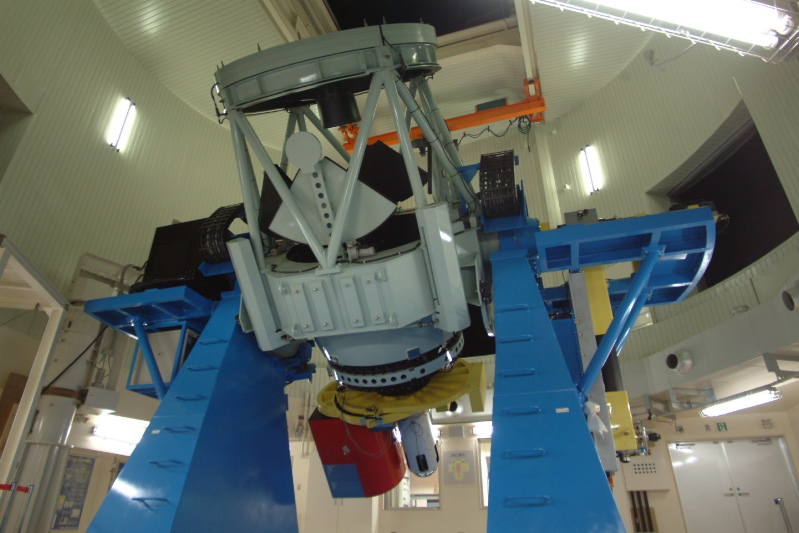
2m NAYUTA telescope
(the largest telescope in Japan, and the largest public telescope in the
world).
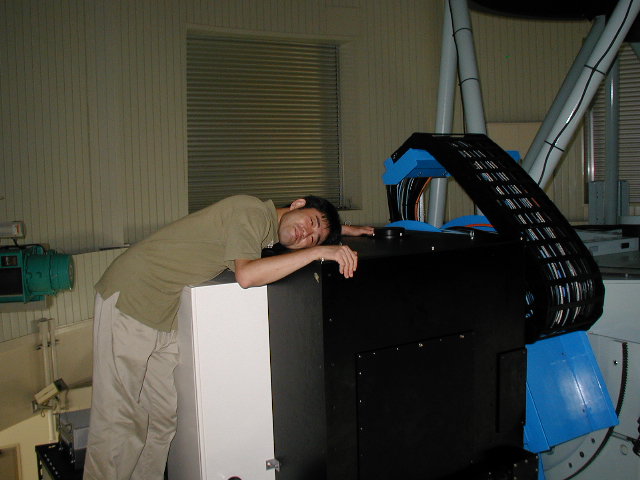
Spectrograph for NAYUTA (Nasmyth focus F12,
R=7500 at 5000 A, Wavelength resolution=0.6 A, wavelength width = 400 A)
and its producer Dr.S.Ozaki.
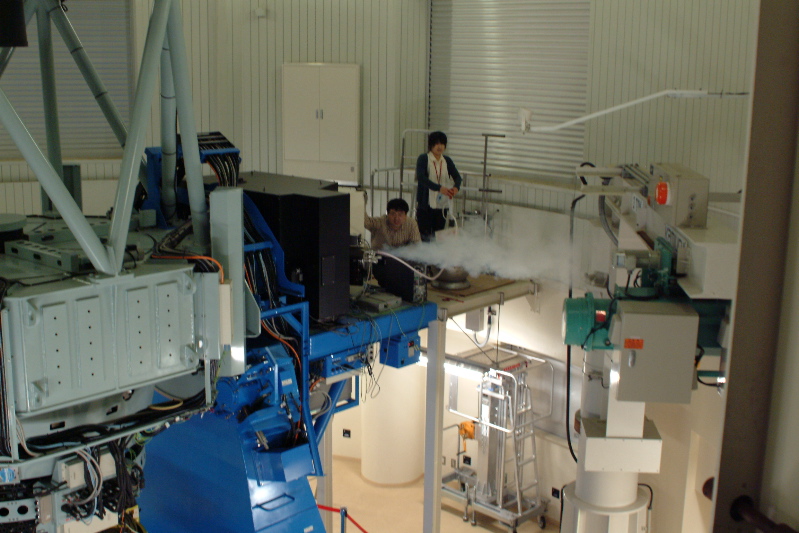
Liquid N2 are injected into the CCD camera of the MALLS.
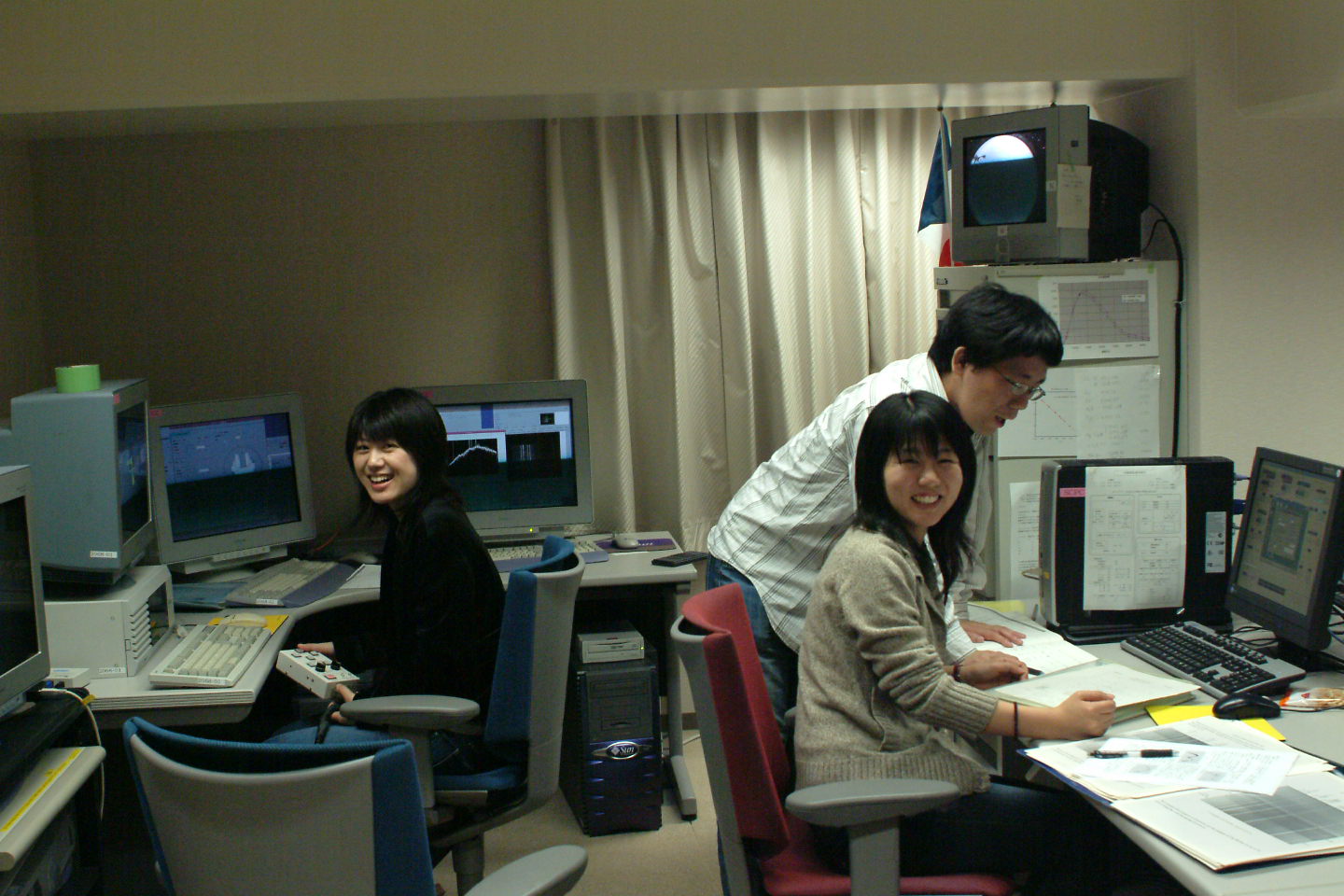
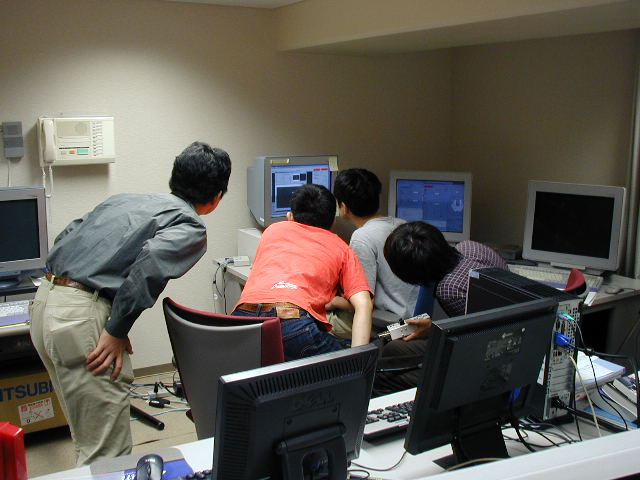
observations

data reduction
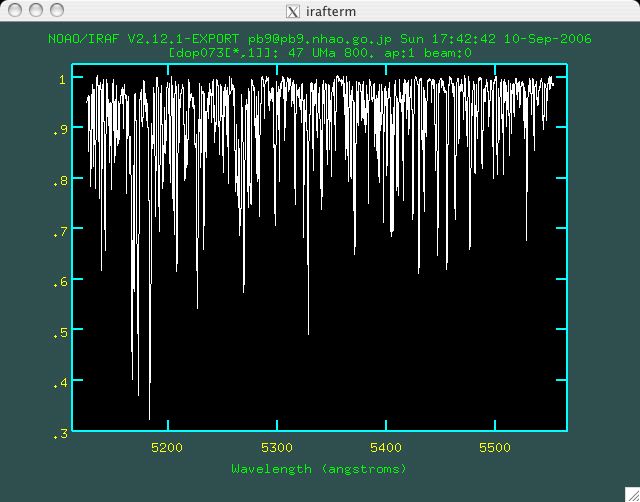
An observed spectrum (47 UMa, SN=1000).
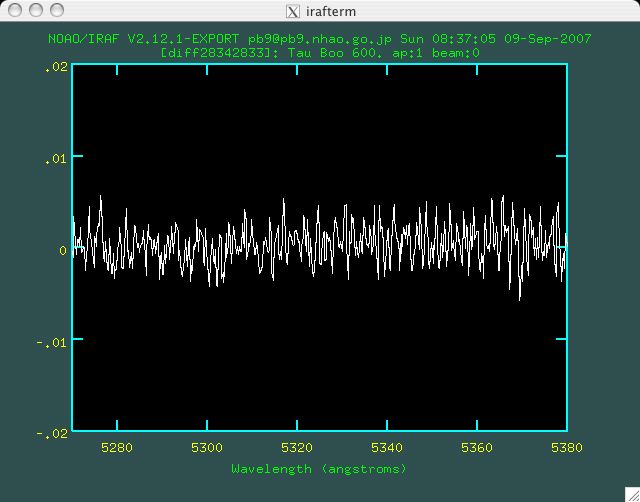
A differential spectrum (sigma = 0.002).
Central wavelength is 5320.7A (SHG of YAG R2->Y3 laser).
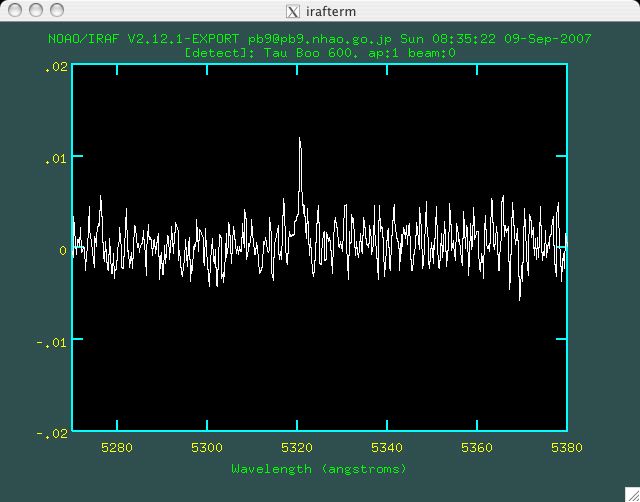
The synthesized laser emission (6 * sigma).
(Be careful! This is the not ETI signal.)

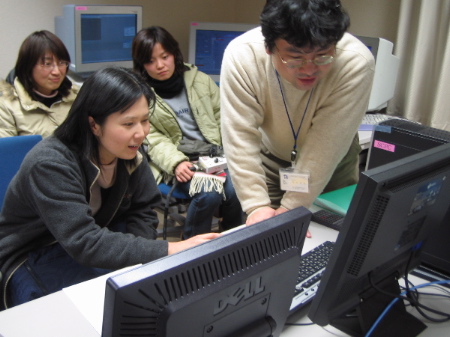
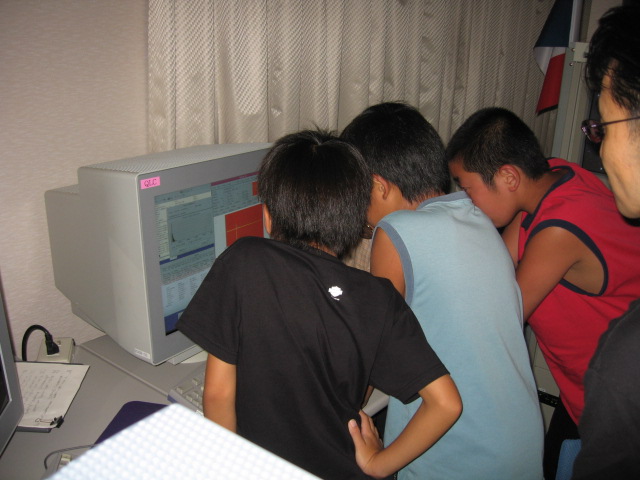
The general were invited to observations.
Table 2: Obsevational log
2005
07 Sep. Rho CrB (preliminary observation)
17 Sep. 51 Peg (preliminary observation)
20 Oct. 51 Peg (preliminary observation)
04 Nov. 51 Peg @
12 Nov. 51 Peg @
02 Dec. 47 UMa @
2006
23 Jan. 55 Cnc, Rho CrB
26 Jan. 55 Cnc
27 Jan. 55 Cnc @
11 Feb. 55 Cnc @
24 Mar. 55 Cnc @
31 Mar. 55 Cnc @
25 Apr. Pollux
25 May Rho CrB
26 Jul. 51 Peg
27 Jul. 51 Peg
30 Jul. RhoCrB
03 Aug. 51 Peg
06 Aug. 51 Peg
07 Aug. 51 Peg
08 Aug. Rho CrB
15 Aug. 51 Peg
25 Aug. 51 Peg
29 Aug. 51 Peg
01 Sep. 51 Peg
08 Sep. 51 Peg @
03 Oct. 51 Peg
13 Oct. 51 Peg @
2007
03 Feb. HD49674, Pollux @
07 Mar. Tau Boo
13 Mar. Tau Boo
26 Apr. Gl 581
27 Apr. Gl 581
31 May Gl 581
01 Jun. Gl 581
26 Jul. Gl 581, 51 Peg
15 Aug. Gl 581, 51 Peg @
05 Oct. 51 Peg
02 Nov. 51 Peg @
03 Nov. 51 Peg (SETI workshop)
2008
10 Feb. 55 Cnc
22 Feb. 55 Cnc @
11 Mar. 70 Vir (cooperative observation with the Kyushu Tokai University)
12 Mar. 70 Vir (do.)
14 Mar. 70 Vir (do.)
31 May Gl 581
08 Jul. Gl 880
01 Oct. Gl 880
16 Oct. Gl 880, 55 Cnc
04 Nov. Gl 880, 55 Cnc
15 Dec. Gl 880, HIP 107395, HD 69830
2009
24 Mar. 55 Cnc
28 Mar. 55 Cnc (rehearsal observation of Project Sazanka)
28 Apr. Gl 526
01 May 55 Cnc (cooperative observation with the Tokai University)
08 May Gl 526
09 May Gl 526
26 Nov. HIP 107395 (cooperative observation with the Tokai University)
27 Nov. HIP 107395 (do.)
@: ordinary citizens were invited to observations under the "NHAO at site program (Sakamoto et al. 2008)"
Target stars
Rho CrB, 51 Peg, 47 UMa, Tau Boo, 70 Vir and HD 49674:
Stars whose planets can remain in the Goldilocks Zone at least the 1000Myr. Jones et al. (2005, 2006) have performed such examinations for Earth-mass planets of exoplanetary systems.
Gl 581: At least one planet (Gl 581 d, 7 Earth Mass) locate in the Goldilocks Zone (von Paris 2010, Wordsworth et al. 2010, 2011, Hu and Ding 2011)
55 Cnc: One (55 CnC f, 0.14 Jupiter Mass) of five planets is located in the Goldilocks Zone (Fischer et al. 2008, von Braun et al. 2011).
HD 69830:
The outermost (HD 69830 d, 1 Neptune Mass) of 3 planets may reside in this star's Goldilocks Zone (Lovis et al. 2006, Rugheimer and Haghighipour 2007).
Gl 880, Gl 526 and HIP 107395: HabCat (Catalog of Habitable Stellar System, Turnbull and Tarter 2003) star
Pollux: nearby solar type star
References
Beskin et al. 1997 Astrophysics and Space Science 252, 51
Fischer et al. 2008 Astrophysical Journal 675, 790
Howard et al. 2004 Astrophysical Journal 613, 1270
Hu and Ding 2011 Astronomy and Astrophysics 526, A135
Jones, B. W., Underwood, D. R. and Sleep, P. N. 2005 Astrophysical Journal 622, 1091
Jones, B. W., Sleep, P. N. and Underwood, D. R. 2006 Astrophysical Journal 649, 1010
Lovis, C. et al. 2006 Nature, 441, 305
Ozaki, S. and Tokimasa, N. 2005 Annu. Rep. of NHAO 15, 5 (in Japanese)
Reines, A. E. and Marcy, G. W. 2002 Publications of the Astronomical Society of the Pacific 114, 416
Rugheimer and Haghighipour 2007 Bulletin of the American Astronomy Society 38, 203
Sakamoto, M. 2008 in Global Hands-On Universe 2007 For Win-Win Relations Between Science Research and Education, eds. T.Handa & M.Okyudo (Tokyo, Universal Academy Press, Inc.), p.123
Schwartz, R. M. and Townes, C. H. 1961 Nature 190, 205
Turnbull and Tarter 2003 Astrophysical Journal Supplement Seres 145, 181
von Braun et al. 2011 Astrophysical Journal 740, 49
von Paris et al. 2010 Astronomy and Astrophysics 522, A23
Wordworth et al. 2010 Astronomy and Astrophysics 522, A22
Wordworth et al. 2011 Astrophysical Journal Letter 733, L48
Papers
Narusawa, S. & Morimoto, M. (2007)
hOptical SETI observations with the NAYUTA telescopeh (pdf)
Annu. Rep. Nishi-Harima Astron. Obs. 17, 1
Narusawa, S. (2011)
hOptical SETI observations with the NAYUTA telescope IIh (pdf)
Annu. Rep. Nishi-Harima Astron. Obs. 21, 1
Presentations
We have presented about NAYUTA OSETI at the Astrobiology Science Conference 2012 (Apr. 17, 2012)
Narusawa, S. & Sakamoto, M. (2012)
OSETI with the general public and discussion on the IAA SEI protocol
Societal Impact of Discovering Extraterrestrial Life Posters (#2436)

Atlanta













